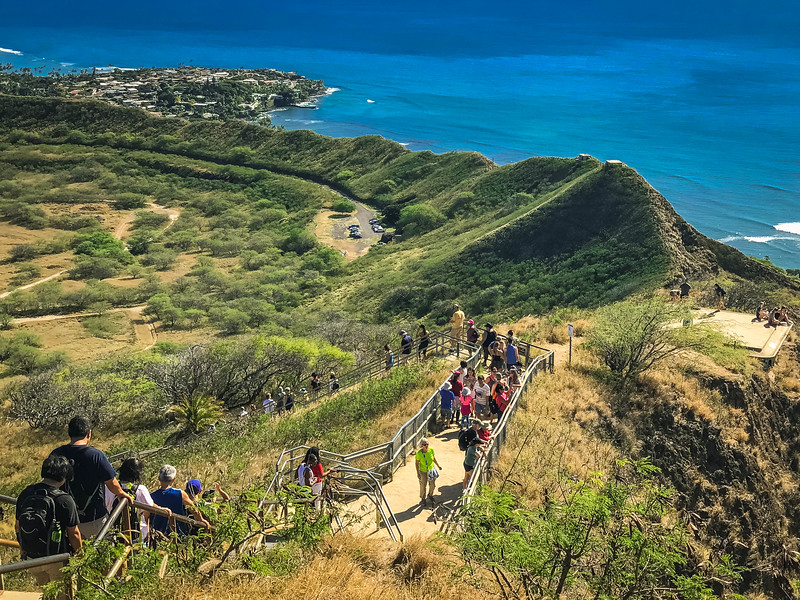Climbing Diamond Head is an adventure that many travelers find themselves contemplating when they visit the spectacular island of Oahu. But beyond the novelty of scaling one of Hawaii’s most iconic volcanic craters lies a series of questions and insights that delve deeper into this invigorating journey. How many steps must you conquer? What level of difficulty can one expect on this historic trail? Let’s explore the nuances of climbing Diamond Head and uncover the myriad reasons why this trek should firmly occupy a place on your travel agenda.
First, let’s address the most pressing question: how many steps does it take to reach the summit of Diamond Head? The primary trail, which meanders through a landscape steeped in history and natural beauty, contains roughly 1,000 steps. This figure, however, can be somewhat deceptive. It is not merely the number of steps that challenges climbers, but also the nature of the ascent itself. Along the journey, one will encounter a variety of terrains: paved pathways, dusty trails, and stone steps. The steepness of some sections—including a series of steep, narrow staircases—combined with the subtropical heat, can transform this moderate hike into an exhilarating challenge.
While the ascent might be physically demanding, it is essential to consider the payoff. Upon reaching the summit, climbers are rewarded with panoramic views that are nothing short of breathtaking. The landscape unfolds in a vivid tapestry, featuring the cerulean waters of the Pacific Ocean, the sprawling city of Honolulu, and majestic mountains that cradle the island. This stunning vista is often cited as the principal catalyst for the fascination surrounding Diamond Head. It represents not merely a physical accomplishment but an emotional one—a culmination of effort that allows one to connect deeply with the natural beauty and cultural history of Hawaii.
The Diamond Head summit trail is more than just a hike; it is an exploration of volcanic geology and an escape into the serene wilderness. This 0.8-mile trail winds through the 300,000-year-old crater, offering unique glimpses into the geological processes that have shaped Oahu. The very essence of Diamond Head is imbued with a sense of wonder, inviting travelers to ponder its transformative journey from a violent eruption to a tranquil landscape. As you ascend, notice the flora and fauna that flourish in this micro-ecosystem. Many species are indigenous to Hawaii and tell stories of resilience and adaptation, enmeshing nature and culture in a singular experience.
Another vital aspect of climbing Diamond Head is understanding the context and significance of this landmark in Hawaiian history. Originally named Le’ahi, translating to “brow of the ‘tuna,'” this iconic cone was once a strategic military lookout. Built in 1908, the fire control station remains a historical artifact atop the summit, a tangible link to the past that adds layers of intrigue to your adventure. As you reach the summit, take a moment to reflect on its historical importance during World War II; it’s this entwining of nature and history that adds depth to the hike.
Now, let’s address the aspect of difficulty. While the challenge of climbing Diamond Head can vary depending on personal fitness, it is generally classified as a moderate hike. Novice hikers can certainly tackle it, though being prepared is key. Hydration is crucial, particularly under the relentless Hawaiian sun, and sturdy footwear is advisable to navigate the rocky and potentially slippery terrain. Also, consider starting early in the day to avoid the heat and take advantage of cooler temperatures. Many hikers find that the early morning climb enhances the experience, providing opportunities to witness the sunrise illuminating the horizon before your eyes.
As you embark on your journey, be mindful of the camaraderie exhibited by fellow hikers. It’s common to engage in light-hearted banter and share encouragement along the trail. This communal spirit enhances the overall experience, echoing the island’s cultural emphasis on ohana, or family. The journey becomes a shared endeavor, giving rise to connections and memories that extend beyond the hike itself.
Post-hike, take time to revel in the experience. Whether you choose to explore the surrounding areas or simply rest among the lush vegetation, the summit offers a perfect spot for reflection. Many climbers relish the opportunity to padlock this memory into the core of their travel experiences. Capture the moment with photographs, soak in the diversity of life below, or simply bask in the tranquility that surrounds you. This experience is often described as both physically and spiritually rewarding, inviting introspection and celebration of what your body has achieved.
In conclusion, climbing Diamond Head encompasses far more than just the physical endeavor of ascending a volcano. It invites introspection, communal experience, and an appreciation for the intricate relationship between nature and history that defines the island of Oahu. Whether you are an intrepid adventurer or a casual hiker, the challenge of Diamond Head is well worth the effort. The 1,000 steps lead not only to a stunning vista but also to a profound connection with the land, its history, and the indomitable spirit of Hawaii. Embrace the climb, and let it be a cherished chapter in your travel narrative.
